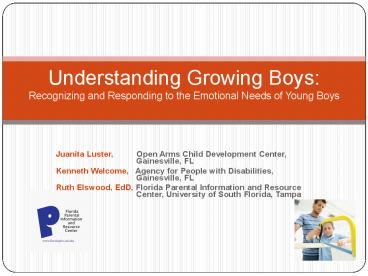Juanita Luster, Open Arms Child Development Center, Gainesville, FL - PowerPoint PPT Presentation
1 / 15
Title:
Juanita Luster, Open Arms Child Development Center, Gainesville, FL
Description:
'America's boys are in trouble. ... Boys' emotional needs are going largely unrecognized and, consequently, unmet. ... Many boys, especially those in poor ... – PowerPoint PPT presentation
Number of Views:113
Avg rating:3.0/5.0
Title: Juanita Luster, Open Arms Child Development Center, Gainesville, FL
1
Understanding Growing Boys Recognizing and
Responding to the Emotional Needs of Young Boys
- Juanita Luster, Open Arms Child
Development Center, Gainesville, FL - Kenneth Welcome, Agency for People with
Disabilities, Gainesville, FL - Ruth Elswood, EdD, Florida Parental Information
and Resource Center, University of South
Florida, Tampa
2
From Raising Cain by Michael Thompson and Dan
Kindlon¹
- Americas boys are in trouble.
- Americas boys are destined for lives of
isolation, shame, and anger. - Boys emotional needs are going largely
unrecognized and, consequently, unmet. - Schools, especially early childhood environments
are predominantly female cultures.
3
From Geoffrey Canada²
- Many boys, especially those in poor inner-city
environments lack positive male role models in
their lives. - Because of this lack many turn to substitute
families in the form of gangs. - Death rates from violence among inner-city young
males, especially African American males are at
unprecedented levels.
4
Boys Emotional Development
- True or False?
- Two year-old boys are more physically aggressive
than two-year-old girls. - True or False?
- Three-year-old boys are more physically
aggressive than three-year-old girls. - True or False?
- Infant girls are more emotionally vulnerable than
infant boys.
5
Intellectual development
- True or False?
- Boys make up two-thirds of the student population
in special education classrooms. - True or False?
- There are more girls than boys in the top 2 of
the IQ scale.³
6
From National Center for Educational Statistics
(http//nces.ed.gov)
- Boys are 30 more likely than girls to drop out
of school. - When it comes to grades and homework, girls
outperform boys in elementary, secondary, high
school, college, and even graduate school. - Boys are 4 to 5 times more likely than girls to
be diagnosed with ADHD. - Women outnumber men in higher education with 56
of bachelors degrees and 55 of graduate degrees
going to women.
7
A young boys internal life
- Where the Wild Things Are by Maurice Sendak
- Boy plays roughly boy gets into trouble boy
gets sent to his room boy saves the world from
wild beasts boy goes home to where someone
loves him best of all.
8
Schools have changed, not boys
- Schools have become female dominated
environments with constant oversight and
intervention.
9
Classroom Strategies
- Bring strong, positive male role models into the
classroom in the form of fathers, grandfathers,
volunteers, uncles, etc. - Let boys play physical games. Ask male volunteers
to lead these activities. - Create learning activities where boys can use
their bodies. - With guidance allow topics that interest boys
that have in recent years become taboo.
10
Strategies, contd
- Allow boy humor.
- Dont be hard on the class clown, embrace his
humor and allow jokes at appropriate times. - Cultivate a sense of humor about boys sense of
humor. - Use literature when male role models are not
available. - Include male parent figures in
- conversations about their children.
11
In the classroom some questions to ask yourself
- Are the boys actively encouraged to play in the
dramatic play or housekeeping center? - Is there regular physical activity not just on
the playground, but scheduled throughout the day? - Are fathers valued and included daily?
- Are kinetic learning styles accommodated, e.g.
opportunity to stand up to paint, - large paper at easels for writing practice,
- chalk board and chalk for writing?
12
In the classroom, contd
- What safe opportunities are there for physical,
rough and tumble-type play? - Are all boys expected to be physical and
boisterous in their play? - Is there approval for boys who are naturally
quiet and shy? - Are there books available and read aloud that
acknowledge boys and mens - internal lives?
13
Keys to raising emotionally strong boys (Thompson
and Kindlon)
- Boys need permission to have an internal life
respect it, refer to it, share your own internal
life. - Accept and allow that boys need a high level of
physical activity. - Use boy language to talk to boys.
14
References
- Thompson, M. and Kindlon, D. (1999) Raising Cain
Protecting the Emotional Life of Boys. Ballantyne
Books. - Canada, G. (1998) Reaching up for Manhood
Transforming the Lives of Boys in America. Beacon
Press. - Deary, I.J., Irwing, P., Der, G., Bates, T.C.
(2005). Brother-sister differences in the g
factor in intelligenceAnalysis of full,
opposite-sex siblings from the NLSY 1979.
Intelligence 35 451-456.
15
Please complete evaluation































